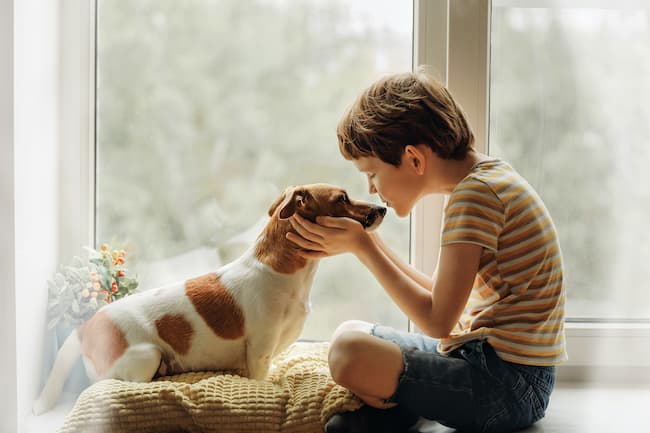by Dr. Dani McVety, Founder and CEO of Lap of Love Veterinary Hospice.
For children, the loss of a pet is often their first experience with death. Children tend to grieve differently than adults do, and they need lots of love, guidance, and support. Parents often want to shelter children from death, which is understandable, but honesty can be the best thing. Each child is unique, and each age group and stage of development can have different reactions.
The decision to have children involved and/or present during the end of life care period of a pet’s life is a very important one. Every family has their own wishes and boundaries that must be respected. After years of witnessing hospice and euthanasia in the home, along with watching my own children deal with the loss of pets, I have come to the conclusion that there are three major age groups with which I coach families.
Although chronological age boundaries are used here, it is important to remember that emotional age may vary with gender and mental status. Remember that as parents, you know what is best for your little one.
Years 0-6
Young children will generally be more upset by mom and dad’s emotions than by their own. It is difficult for them to see their parents cry; they cannot yet perceive an ending to that grief. As adults, we understand that being sad in one moment does not mean that we are sad every day. For this age range, I suggest families do not involve the children too much or have them present during a euthanasia. For children old enough to verbalize, a simple “mommy is sad because Fluffy is no longer here,” is generally adequate enough.
Years 6-14
School aged children are incredibly curious, intelligent, and resilient. They never cease to amaze me with their heavenly comments and honest opinions. This is generally the first experience they have with death and losing a companion that has been with them their entire life is quite difficult. Watching their parents cry, sob, or mourn the loss of a pet will teach them how to appropriately deal with and display their feelings. This age group should not be shielded from the experience, but rather asked if they would like to be a part of it. They are old enough to make that decision. Too often I have seen parents’ desire to shelter their children backfire, generally resulting in a phone call to me and visit to the crematory to view the body. This helps the child understand the finality of death but does little to address their fear that Fluffy may have been in pain. This is the reason why, if a child of this age is undecided and the parents request my input, I will gently suggest they “be here for Fluffy,” so that they understand what a peaceful, loving, and calm experience death can be. You may consider hiring a licensed pet loss grief counselor.
Years 14-21
Teenagers and young adults can sometimes be the hardest group to work with when it comes to death. In my experience, this age has a very idealist view of the world. They generally do not understand the concept of suffering and therefore the decision to euthanize can be a difficult one for them to accept; it can feel like mom and dad are “giving up on Fluffy.” When parents allow, I take a great deal of time explaining the situation with this age group. They deserve information and I want them to feel that they are old enough, and important enough, to hear it. Ask open-ended questions with this age, request their feedback and ensure that they understand why and how we are making a medical decision for their pet. They will never forget this experience and we have the ability to help them through it on a small level. Again, if a teenager or young adult is undecided and the parents request my input, I will gently suggest they “be here for Fluffy” so that they understand what a peaceful, loving, and calm experience death can be, with in home pet euthanasia.
When asked about the subject of children and death, a child psychologist once told me, “if you want to raise an angry child, keep him/her ill-informed.” What she was saying is that honesty is always the best policy. Of course, there are levels of honesty that are appropriate for each age group, but at the heart of each conversation is the truth about life and death. We need to remember that just like pets, children grieve in their own unique ways. They deserve permission to mourn along with a good example about the proper ways to do so. How a child responds will always be a reflection of their strength of bond with the pet, their mental status, and of course, age and developmental stage.
About the Author
 In addition to her role as a hospice veterinarian and Founder & CEO of Lap of Love, Dani McVety is a speaker, consultant, author, and host for PetCareTV. With a deep love for the human-animal bond, Dr. Dani enjoys just about anything that has to do with pets! After graduating from college, she practiced emergency medicine and gained a greater understanding of how to help families at a time in which they felt most helpless. This has become her greatest fulfillment in veterinary medicine: helping to ease the stress and fear of the people who love their animals. Already an accomplished entrepreneur before vet school graduation, Dr. Dani partnered with Dr. Mary Gardner about one year after founding Lap of Love. Together they have grown the company into one of the most respected networks of doctors in the veterinary profession, setting the standard for end-of-life care higher than it has ever been before. Dr. Dani graduated from the University of Florida College of Veterinary Medicine and is the youngest recipient of the college’s Distinguished Young Alumni Award (2013), the Florida Veterinary Medical Association’s President’s Award (2014), and most recently, the Pet Industry Woman of the Year (2017).
In addition to her role as a hospice veterinarian and Founder & CEO of Lap of Love, Dani McVety is a speaker, consultant, author, and host for PetCareTV. With a deep love for the human-animal bond, Dr. Dani enjoys just about anything that has to do with pets! After graduating from college, she practiced emergency medicine and gained a greater understanding of how to help families at a time in which they felt most helpless. This has become her greatest fulfillment in veterinary medicine: helping to ease the stress and fear of the people who love their animals. Already an accomplished entrepreneur before vet school graduation, Dr. Dani partnered with Dr. Mary Gardner about one year after founding Lap of Love. Together they have grown the company into one of the most respected networks of doctors in the veterinary profession, setting the standard for end-of-life care higher than it has ever been before. Dr. Dani graduated from the University of Florida College of Veterinary Medicine and is the youngest recipient of the college’s Distinguished Young Alumni Award (2013), the Florida Veterinary Medical Association’s President’s Award (2014), and most recently, the Pet Industry Woman of the Year (2017).


